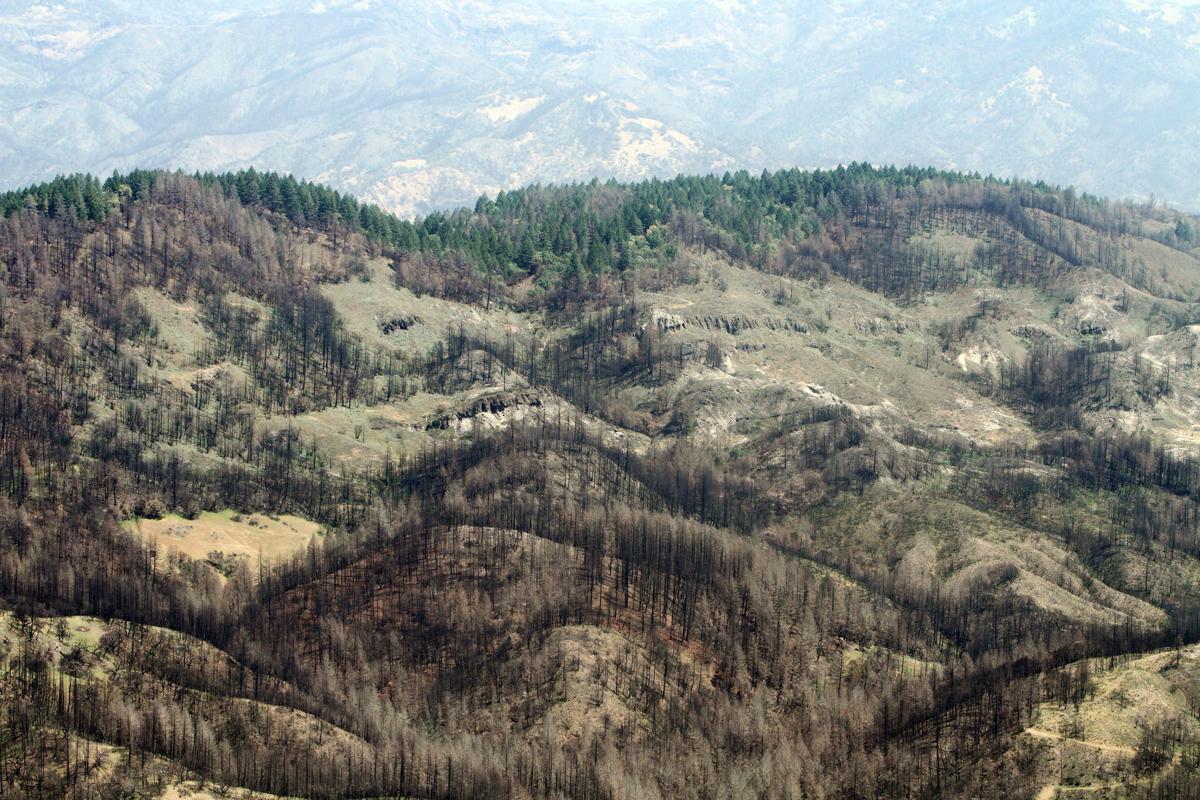
PETALUMA — The scars left behind by North Bay wildfires, and the expanses of woodland still green but ever vulnerable, can be better appreciated from hundreds of feet above.
So says a nonprofit that advocates for the protection of wildlands — and of swaths of the Western states increasingly threatened by devastating firestorms — through aerials tours in single-engine planes.
On Wednesday, EcoFlight took its winged message to the North Bay with a series of aerial tours aboard a Cessna 210 propeller plane that illustrated some of the traces left behind by the infernos of the last half-decade, but also the practices that could better shield Californians in years to come.
On three looping flights from Petaluma Municipal Airport, journalists received a rare top-down look at forested, often rugged terrain menaced by the Nuns and Tubbs fires in 2017 and the Kincade and Glass Fires last fall. But the 45-minute excursion also gave a North Bay fire ecologist a chance to point to the importance of prescribed, preemptive burning to reduce the plant matter that otherwise would remain tinder-in-waiting, more combustible than ever as California endures bouts of drought and fire seasons stretching longer and earlier in the summer than ever.
Based in Aspen, Colorado, EcoFlight is a nonprofit that uses low-altitude plane tours, and videos of such flights, to advocate for the protection of forests and wilderness areas in partnership with local conservation groups. Wednesday’s excursions were EcoFlight’s first in the North Bay, and, according to an organizer, a timely visit for an area that has endured multimillion-dollar destruction and deaths in the past four years — from the devastation of Santa Rosa’s Coffey Park area in 2017 to the destruction of upper Napa Valley homes and vineyard properties in last year’s Hennessey and Glass fires.SKIP AD
“This area has been impacted by wildfires, probably harder than any other in California, and this is a great place to show how comprehensive wildfire solutions have to be,” said Jamie Ervin, a fire restoration advocate for Sierra Forest Legacy and a spokesperson for the Petaluma event.
At altitude, “you can see just how much landscape there is and how quickly the landscape changes,” said Sasha Berleman, a fire ecologist who served as the in-flight guide Wednesday. “This is a unique part of California in some ways because it’s diverse: different ecosystems, different topographies, and different houses and living situations, all mixed together. You can really see that from the air, and get the sense of how complex the situation is and how much people taking that responsibility will make a difference.”
EcoFlight’s founder and pilot Bruce Gordon led observers on a counterclockwise path across a complex tapestry interwoven with roads, buildings, yellowed meadows — and carpets of tree cover. Ten minutes into the tour, the evidence of the threat was as stark as the stands of charred redwood trunks clinging to a hillside, forming a sharp-edged border with unburned evergreens at the edge of the 2017 Nuns Fire.
After passing north of Santa Rosa, the Cessna made a northwest turn toward woodlands southwest of Geyserville where controlled burns were conducted over the winter. Over the in-flight intercom and again after the tour, Berman emphasized the need for more and wider-ranging management of increasingly fire-prone lands, including controlled burns outside of peak fire season by private landowners as well as firefighting agencies.
Such a principle requires teaching citizens about a middle course between intensive logging and a save-every-tree position, Berleman told reporters at the airport following the second flight.
“We’re having to unlearn the idea that if you love nature, you can’t touch it,” she said. “And it’s not just changing hearts and minds; you have to equip people with the skills to go out and do this.”
With federal and state budgets unlikely to provide absolute firefighting protection across Western forests — and a shifting climate lengthening the season of dangerously high temperatures and winds — Berleman asked citizens and officials to begin treating such land management as a part of the basic responsibility of stewardship.
“I think that’s the core of the matter — we all are going to have to take that responsibility and own it in a positive way,” she said. “It doesn’t have to be a heavy negative responsibility; we can choose to see our relationship with these landscapes in a new way, that we have a really valuable role to play. We’re important to nature here and important to the creation and maintaining of resilience. And we need to be doing that now.”